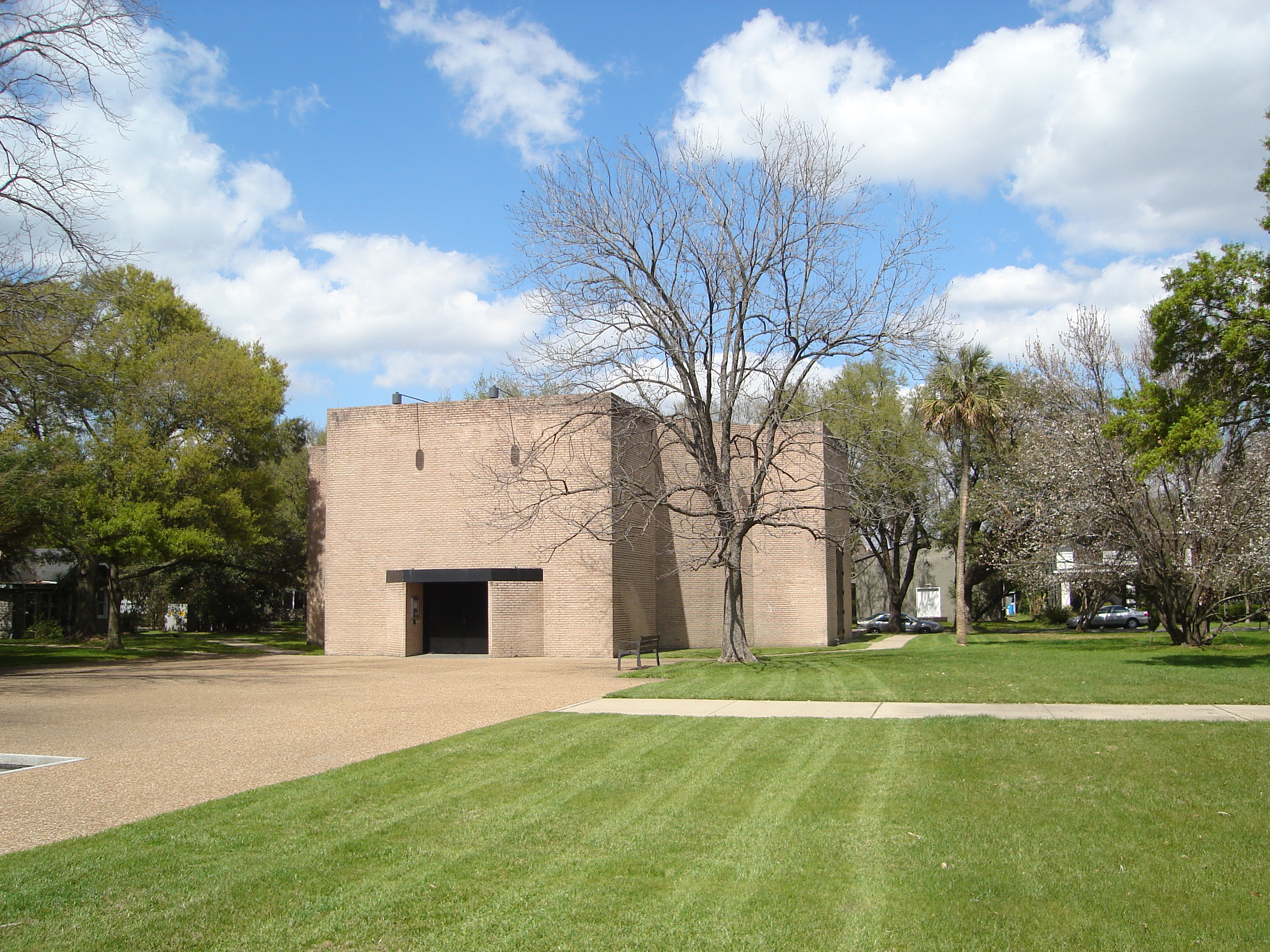|
Smith Campus Center
Harvard University's Smith Campus Center (formerly Holyoke Center) is a brutalist administrative and service building located in Harvard Square, Cambridge, Massachusetts. Opposite the Wadsworth Gate to Harvard Yard on Massachusetts Avenue, it functions as a student center, as well as housing Harvard administrative offices, University Health Services, and a restaurant arcade. Design Primarily designed by José Luis Sert (then dean of the Harvard Graduate School of Design) and completed in 1966, the Smith Campus Center is an H-shaped ten-story reinforced concrete building. Low-rise portions, including an underground parking garage, have a larger footprint of . The building was constructed in two phases over a six-year period between 1960 and 1966. The first phase—the southern half of the building facing Mount Auburn Street—began in 1960 and was occupied in 1962. Construction of the second phase began in 1964 and was completed in 1966. The landscaped area at the corner of Mass ... [...More Info...] [...Related Items...] OR: [Wikipedia] [Google] [Baidu] |
Brutalism
Brutalist architecture is an architectural style that emerged during the 1950s in the United Kingdom, among the reconstruction projects of the post-war era. Brutalist buildings are characterised by minimalist constructions that showcase the bare building materials and structural elements over decorative design. The style commonly makes use of exposed, unpainted concrete or brick, angular geometric shapes and a predominantly monochrome colour palette; other materials, such as steel, timber, and glass, are also featured. Descended from Modernism, brutalism is said to be a reaction against the nostalgia of architecture in the 1940s. Derived from the Swedish phrase ''nybrutalism'', the term "new brutalism" was first used by British architects Alison and Peter Smithson for their pioneering approach to design. The style was further popularised in a 1955 essay by architectural critic Reyner Banham, who also associated the movement with the French phrases '' béton brut'' ("raw c ... [...More Info...] [...Related Items...] OR: [Wikipedia] [Google] [Baidu] |
Edward W
Edward is an English language, English male name. It is derived from the Old English, Anglo-Saxon name ''Ēadweard'', composed of the elements ''wikt:ead#Old English, ēad'' "wealth, fortunate; prosperous" and ''wikt:weard#Old English, weard'' "guardian, protector”. History The name Edward was very popular in Anglo-Saxon England, but the rule of the House of Normandy, Norman and House of Plantagenet, Plantagenet dynasties had effectively ended its use amongst the upper classes. The popularity of the name was revived when Henry III of England, Henry III named his firstborn son, the future Edward I of England, Edward I, as part of his efforts to promote a cult around Edward the Confessor, for whom Henry had a deep admiration. Variant forms The name has been adopted in the Iberian Peninsula#Modern Iberia, Iberian peninsula since the 15th century, due to Edward, King of Portugal, whose mother was English. The Spanish/Portuguese forms of the name are Eduardo and Duarte (name), Duart ... [...More Info...] [...Related Items...] OR: [Wikipedia] [Google] [Baidu] |
Buildings And Structures Completed In 1966
A building or edifice is an enclosed structure with a roof, walls and windows, usually standing permanently in one place, such as a house or factory. Buildings come in a variety of sizes, shapes, and functions, and have been adapted throughout history for numerous factors, from building materials available, to weather conditions, land prices, ground conditions, specific uses, prestige, and aesthetic reasons. To better understand the concept, see ''Nonbuilding structure'' for contrast. Buildings serve several societal needs – occupancy, primarily as shelter from weather, security, living space, privacy, to store belongings, and to comfortably live and work. A building as a shelter represents a physical separation of the human habitat (a place of comfort and safety) from the ''outside'' (a place that may be harsh and harmful at times). buildings have been objects or canvasses of much artistic expression. In recent years, interest in sustainable planning and building pract ... [...More Info...] [...Related Items...] OR: [Wikipedia] [Google] [Baidu] |
Brutalist Architecture In Massachusetts
Brutalist architecture is an architectural style that emerged during the 1950s in the United Kingdom, among the reconstruction projects of the post-war era. Brutalist buildings are characterised by minimalist constructions that showcase the bare building materials and structural elements over decorative design. The style commonly makes use of exposed, unpainted concrete or brick, angular geometric shapes and a predominantly monochrome colour palette; other materials, such as steel, timber, and glass, are also featured. Descended from Modernism, brutalism is said to be a reaction against the nostalgia of architecture in the 1940s. Derived from the Swedish phrase ''nybrutalism'', the term "new brutalism" was first used by British architects Alison and Peter Smithson for their pioneering approach to design. The style was further popularised in a 1955 essay by architectural critic Reyner Banham, who also associated the movement with the French phrases ''béton brut'' ("raw co ... [...More Info...] [...Related Items...] OR: [Wikipedia] [Google] [Baidu] |
Harvard University Buildings
Harvard University is a private Ivy League research university in Cambridge, Massachusetts, United States. Founded in 1636 and named for its first benefactor, the Puritan clergyman John Harvard, it is the oldest institution of higher learning in the United States. Its influence, wealth, and rankings have made it one of the most prestigious universities in the world. Harvard was founded and authorized by the Massachusetts General Court, the governing legislature of colonial-era Massachusetts Bay Colony. While never formally affiliated with any denomination, Harvard trained Congregational clergy until its curriculum and student body were gradually secularized in the 18th century. By the 19th century, Harvard emerged as the most prominent academic and cultural institution among the Boston elite. Following the American Civil War, under Harvard president Charles William Eliot's long tenure from 1869 to 1909, Harvard developed multiple professional schools, which transforme ... [...More Info...] [...Related Items...] OR: [Wikipedia] [Google] [Baidu] |
Drew Gilpin Faust
Catharine Drew Gilpin Faust (born September 18, 1947) is an American historian who served as the 28th president of Harvard University, the first woman in that role. She was Harvard's first president since 1672 without an undergraduate or graduate degree from Harvard and the first to have been raised in the South. Faust is also the founding dean of the Radcliffe Institute for Advanced Study. She has been ranked among the world's most powerful women by ''Forbes'', including as the 33rd most powerful in 2014. Early life and education Drew Gilpin was born in New York City and raised in Clarke County, Virginia, in the Shenandoah Valley. She is the daughter of Catharine Ginna (née Mellick) and McGhee Tyson Gilpin. Her father was a Princeton graduate and bred thoroughbred horses, among other business ventures. Her paternal grandfather, Kenneth Newcomer Gilpin, was a businessman who served in the Virginia House of Delegates (representing Clarke and adjacent Warren Counties) and ... [...More Info...] [...Related Items...] OR: [Wikipedia] [Google] [Baidu] |
Harvard Art Museums
The Harvard Art Museums are part of Harvard University and comprise three museums: the Fogg Museum (established in 1895), the Busch-Reisinger Museum (established in 1903), and the Arthur M. Sackler Museum (established in 1985), and four research centers: the Archaeological Exploration of Sardis (founded in 1958), the Center for the Technical Study of Modern Art (founded in 2002), the Harvard Art Museums Archives, and the Straus Center for Conservation and Technical Studies (founded in 1928). The three museums that constitute the Harvard Art Museums were initially integrated into a single institution under the name Harvard University Art Museums in 1983. The word "University" was dropped from the institutional name in 2008. The collections include approximately 250,000 objects in all media, ranging in date from antiquity to the present and originating in Europe, North America, North Africa, the Middle East, South Asia, East Asia, and Southeast Asia. The main building contains o ... [...More Info...] [...Related Items...] OR: [Wikipedia] [Google] [Baidu] |
Abstract Expressionist
Abstract expressionism in the United States emerged as a distinct art movement in the aftermath of World War II and gained mainstream acceptance in the 1950s, a shift from the American social realism of the 1930s influenced by the Great Depression and Mexican muralism, Mexican muralists. The term was first applied to American art in 1946 by the art critic Robert Coates (critic), Robert Coates. Key figures in the New York School (art), New York School, which was the center of this movement, included such artists as Arshile Gorky, Jackson Pollock, Franz Kline, Mark Rothko, Norman Lewis (artist), Norman Lewis, Willem de Kooning, Adolph Gottlieb, Clyfford Still, Robert Motherwell, Theodoros Stamos, and Lee Krasner among others. The movement was not limited to painting but included influential collagists and sculptors, such as David Smith (sculptor), David Smith, Louise Nevelson, and others. Abstract expressionism was notably influenced by the spontaneous and subconscious creation met ... [...More Info...] [...Related Items...] OR: [Wikipedia] [Google] [Baidu] |
Mark Rothko
Mark Rothko ( ; Markus Yakovlevich Rothkowitz until 1940; September 25, 1903February 25, 1970) was an American abstract art, abstract painter. He is best known for his color field paintings that depicted irregular and painterly rectangular regions of color, which he produced from 1949 to 1970. Although Rothko did not personally subscribe to any one school, he is associated with the American abstract expressionism movement of modern art. Born to a Jews, Jewish family in Daugavpils, Latvia, then part of the Russian Empire, Rothko emigrated with his parents and siblings to the United States, arriving at Ellis Island in late 1913 and originally settling in Portland, Oregon. He moved to New York City in 1923 where his youthful period of artistic production dealt primarily with urban scenery. In response to World War II, Rothko's art entered a transitional phase during the 1940s, where he experimented with mythological themes and Surrealism to express tragedy. Toward the end of the d ... [...More Info...] [...Related Items...] OR: [Wikipedia] [Google] [Baidu] |
White Elephant
A white elephant is a possession that its owner cannot dispose of without extreme difficulty, and whose cost, particularly that of maintenance, is out of proportion to its usefulness. In modern usage, it is a metaphor used to describe an object, construction project, scheme, business venture, facility, etc. considered expensive but without equivalent utility or value relative to its capital (acquisition) and/or operational (maintenance) costs. Historical background The term derives from the sacred white elephants kept by Southeast Asian monarchs in Burma, Thailand (Siam), Laos and Cambodia. To possess a white elephant was regarded—and is still regarded in Thailand and Burma—as a sign that the monarch reigned with justice and power, and that the kingdom was blessed with peace and prosperity. The opulence expected of anyone who owned a beast of such stature was great. Monarchs often exemplified their possession of white elephants in their formal titles (e.g., Hsinbyushin, ... [...More Info...] [...Related Items...] OR: [Wikipedia] [Google] [Baidu] |
Hydronics
Hydronics () is the use of liquid water or gaseous water (steam) or a water solution (usually glycol with water) as a Heat transfer, heat-transfer medium in heating system, heating and cooling systems. The name differentiates such systems from Oil cooling, oil and refrigerant systems. Historically, in large-scale commercial buildings such as high-rise and campus facilities, a hydronic system may include both a chilled and a heated water loop, to provide for both heating and air conditioning. Chillers and cooling towers are used either separately or together as means to provide water cooling, while boilers heat water. A recent innovation is the chiller boiler system, which provides an efficient form of HVAC for homes and smaller commercial spaces. District heating Many larger cities have a district heating system that provides, through underground piping, publicly available high temperature hot water and chilled water. A building in the service district may be connected to the ... [...More Info...] [...Related Items...] OR: [Wikipedia] [Google] [Baidu] |







